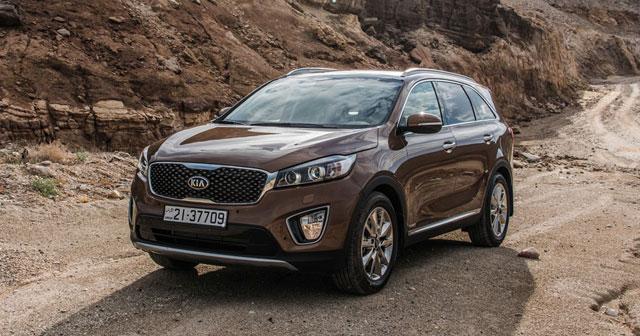You are here
Kia Sportage 1.6 T-GDI GT Line (DCT): Classy yet accessible compact crossover
By Ghaith Madadha - Aug 22,2016 - Last updated at Aug 22,2016

Photo courtesy of Kia
On the market since 1993 and before the compact crossover became a runaway success and distinct automotive segment. An early if somewhat unlikely trendsetter offering a mix of practicality and value, the Sportage has come a long way since, with the latest and most advanced fourth generation debuting earlier this year.
An ambitious and confident vehicle setting out to take on European and Japanese rivals head on, the Sportage is a markedly classier, more refined and dynamically resolved vehicle than the one it replaces. Boasting new infotainment, convenience and driver assistance technologies and perky and sporty 1.6-litre turbocharged engine, the nimble new Sportage’s chassis enhancements also make it a more refined and agile drive.
Stiffer and sportier
Assertive and taut, the new Sportage’s evolution of Kia’s corporate “tiger” nose fascia features a larger low-set grille for improved engine cooling, and higher set headlights stretching back to scalloped bonnet edges. From rear quarter view, it is bulging and athletic, with tight rear lights, strong shoulders and rear arches.
With smooth yet discretely muscular surfacing, swept back tapering lines and pert rear with tailgate spoiler, the Sportage’s silhouette carries a sense of urgent momentum. The sportier GT Line model driven features “ice cube” LED fog lamps, dual exhaust tips, large 19-inch alloy wheels and aluminium effect front skid plate and rear diffuser style lower lips.
Utilising 51 per cent Advanced High Strength Steel content compared with its predecessor’s 18 per cent, the stiffer new Sportage is designed for improved ride, handling, refinement and crash safety. With particular emphasis on stiffer pillars, sills, wheel arches and roof, torsional rigidity improves by 39 per cent, and with extensive safety features, the new Sportage earns a maximum 5-star EuroNCAP safety rating.
Versatile delivery
Powered by same but detuned version of the turbocharged direct injection 1.6 T-GDI four-cylinder engine from the European market Kia Pro_cee’d GT hot hatch, the Sportage GT Line develops 175BHP at 5500rpm and 195lb/ft at 1500-4500. Driving front wheels normally and diverting power rearwards when for additional traction, the GT Line sprints through 0-100km/h in 9.1 seconds and can achieve 201km/h.
Confident off-the-line and responsively versatile throughout a muscular broad mid-range, the Sportage’s T-GDI gives a slight 6BHP power disadvantage but gains 20lb/ft torque over its naturally aspirated 2.4-litre sister model. Capable of a higher top speed owing to more torque yet only marginally quicker in acceleration, the difference is in the T-GDI’s more urgent rather than progressive delivery.
Were the Sportage GT Line been offered with the Pro_cee’d GT’s more potent 201BHP, it would have carved out a distinctly more sporty position than the Sportage 2.4. However, as is, it achieves significant fuel efficiency advantage of 7.5l/100km combined, which is more important for drivers in the family-oriented compact crossover segment.
Nimble and sure-footed
Exclusively offered with a 7-speed automated dual clutch gearbox in place of other Sportage models’ conventional 6-speed automatic option the 1.6 T-GDI benefits from crisper and quicker shifts, especially in “sport” mode. With separate clutches lining up sequential ratios, shifts are smooth and concise, but yet more responsive manual mode shifting would be welcome.
Using independent MacPherson strut front and multi-link rear suspension — now with dual lower-arms — the new Sportage has been upgraded to provide improved ride and handling qualities. Featuring stiffer bushings with revised mounting points and improved isolation, the Sportage also gets stiffer wheel bearings and cross member, revised dampers and suspension geometry, and more direct, fluent and refined steering.
More refined, stable and sporty than its predecessor, the new Sportage’s dynamic improvements were evident on test drive. Having recently recruited a former BMW M Division vice president with an eye on developing their cars handling properties, Kia’s efforts were evident on winding UAE hill climbs, through which the Sportage felt nimble, agile and sharp.
Classy and comfortable
Tucking tidily into corners, the Sportage’s steering feels tighter and precise on-centre and weighs up nicely through bends. Eager, tidy and grippy with little evidence of understeer, the Sportage well controlled lateral weight shifts through corners. Running on firmer and grippier 245/45R19 tyres, the Sportage was smooth, settled and reassuring on highway, with a good compromise between ride comfort and sporty manners.
Refined and quiet over imperfect surfaces, the new Sportage’s noise, vibration and harshness isolation is well improved. Classier and more comfortable inside, the new Sportage features logical, uncluttered and ergonomic dash and console design extensively uses soft textures and quality trim in prominent places. A 40mm longer wheelbase improves stability and rear passenger space, while cabin access and headroom are good for its segment.
Ergonomic with good driving position, 10-way adjustable driver’s seat and firmer more supportive centre cushion and improved rear seat tilt adjustability, the GT Line’s dual clutch gearbox lever is better positioned than the automatic models’. Infotainment, safety and convenience options include 8-inch touchscreen, reversing camera, wireless phone charging, automatic tailgate opening, and blindspot, high beam and lane change warning and assistance systems.
TECHNICAL SPECIFICATIONS
Engine: 1.6-litre, transverse, turbocharged 4 cylinders
Bore x stroke: 77 x 85.44mm
Compression ratio: 10:1
Valve-train: 16-valve, DOHC, variable valve timing, direct injection
Gearbox: 7-speed dual clutch automated, four-wheel drive
Ratios: 1st 3.929; 2nd 2.318; 3rd 2.043; 4th 1.070; 5th 0.822; 6th 0.884; 7th 0.721; R 5.304
Final drive 1, 2, 4, 5/3, 6, 7, R: 4.333/3.25
Power, BHP (PS) [kW]: 175 (177) [130] @5,500rpm
Specific power: 110BHP/litre
Power-to-weight: 114BHP/tonne
Torque, lb/ft (Nm): 195 (265) @1,500-4,500rpm
Specific torque: 166.5Nm/litre
Torque-to-weight: 172.75Nm/tonne
0-100 km/h: 9.1-seconds
Top speed: 201km/h
Fuel economy, urban/extra-urban/combined: 9.2-/6.5-/7.5-litres/100km
CO2 emissions, combined: 175g/km
Fuel capacity: 62-litres
Length: 4,480mm
Width: 1,855mm
Height: 1,635mm
Wheelbase: 2,670mm
Track, F/R: 1,613/1,625mm
Overhang, F/R: 910/900mm
Headroom, F/R: 997/993mm
Legroom, F/R: 1,129/970mm
Shoulder room, F/R: 1,450/1,400mm
Hip room, F/R: 1,380/1,300mm
Cargo capacity, min/max: 491/1,480 litres
Aerodynamic drag co-efficient: 0.33
Kerb weight: 1,534kg
Suspension: MacPherson struts/multi-link, anti-roll bars
Steering: Electric assistance, rack & pinion
Turning circle: 10.6 metres
Lock-to-lock: 2.71 turns
Brakes, F/R: Ventilated discs, 305mm/discs, 302mm
Tyres: 245/45R19
Related Articles
A car-like SUV, the crossover segment’s origins are difficult to pin down.
Having made huge sales and brand equity gains following the 2008 financial crisis as other automotive brands suffered, Hyundai are now at th
With accelerated model development and update cycles, Kia is becoming ever more responsive to customer requirements and changing trends, and has blurring the lines between a mid-life facelift and an all-new model. Though longer than the car it replaces, the 2015 Kia Sorento at first seems like an update.


















